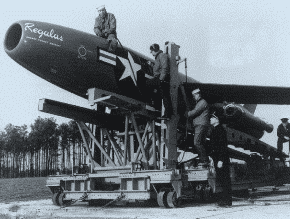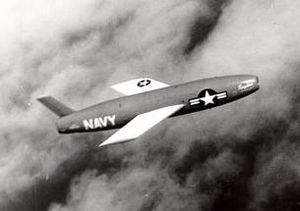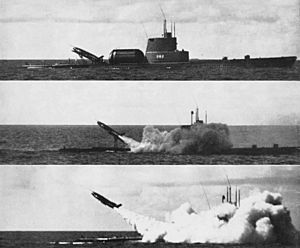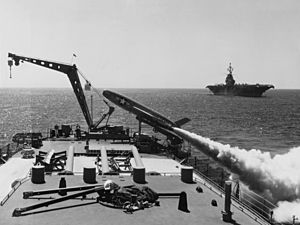SSM-N-8 Regulus facts for kids
The SSM-N-8A Regulus, also known as Regulus I, was a special type of missile used by the United States Navy. It was a cruise missile that could be launched from ships and submarines. This missile was powered by a turbojet engine, similar to those in jet planes. It was designed to carry a nuclear warhead. The Regulus I was used from 1955 to 1964.
Its design was inspired by tests the U.S. Navy did with the German V-1 flying bomb during World War II. The Regulus looked a bit like a small airplane without a cockpit. Early test versions even had landing gear, so they could take off and land like a plane! When ready for use, the missiles were launched from a rail and used special booster rockets to get into the air.
Quick facts for kids SSM-N-8 Regulus |
|
|---|---|
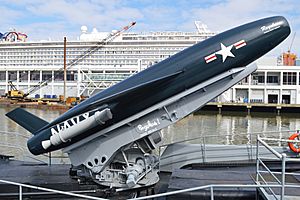
SSM-N-8 "Regulus I" display at Intrepid Sea, Air & Space Museum
|
|
| Type | Cruise missile |
| Place of origin | United States |
| Service history | |
| In service | 1955-64 |
| Used by | United States Navy |
| Production history | |
| Manufacturer | Chance Vought |
| Produced | March 1951 |
| Specifications | |
| Mass | 13,685 pounds (6,207 kg) |
| Length | 32 feet 2 inches (9.80 m) |
| Diameter | 4 feet 8.5 inches (1.435 m) |
| Warhead | 3,000 pounds (1,400 kg) such as the W5 warhead or the W27 warhead |
|
|
|
| Engine | Allison J33-A-14 turbojet 4,600 lbf (20 kN) 2 × booster rockets 33,000 lbf (150 kN) |
| Wingspan | 21 feet (6.4 m) extended 9 feet 10.5 inches (3.010 m) folded |
|
Operational
range |
500 nautical miles (926 km) |
| Maximum speed | Subsonic |
Contents
History of the Regulus Missile
How the Regulus Missile Was Designed
In 1943, a company called Chance Vought Aircraft started thinking about a missile. They wanted one that could fly about 300-mile (480 km) and carry a 4,000-pound (1,800 kg) warhead. This idea didn't go anywhere for four years.
Then, in 1947, the United States Air Force ordered a similar missile called the MGM-1 Matador. The Navy quickly decided they needed their own missile. They wanted one that could launch from a submarine and use the same engine as the Matador. This new Navy project was named "Regulus."
The Regulus missile needed to carry a 3,000-pound (1,400 kg) warhead. It had to fly 500 nautical miles (930 km) at a speed of Mach 0.85 (just below the speed of sound). It also had to be very accurate, hitting within 2.5 nautical miles (4.6 km) of its target half the time.
Before Regulus, the Navy experimented with the JB-2 Loon missile. This missile was very similar to the German V-1 flying bomb from World War II. Submarine tests happened from 1947 to 1953. Two submarines, USS Cusk and USS Carbonero, were used for these tests. At first, the missiles were carried on deck, meaning the submarines couldn't dive until after launching.
The Regulus was designed to be about 30 feet (9.1 m) long. It had a wingspan of 10 feet (3.0 m) and weighed between 10,000 and 12,000 pounds (4,500 and 5,400 kg). As mentioned, test versions had landing gear so they could be used again. Once launched, the Regulus was guided to its target by control stations. These stations were usually on submarines or surface ships. Sometimes, chase planes would even guide them remotely.
There was a bit of a competition between the Army and Navy. Both the Matador and Regulus missiles looked similar and used the same engine. They also performed similarly and cost about the same. The United States Department of Defense asked the Navy to see if they could just use the Matador. But the Navy decided their Regulus missile was better for their needs.
Regulus had some good points over the Matador. It needed fewer guidance stations (two instead of three). It could also be launched faster because its booster rockets were already attached when stored. Also, Chance Vought built a special version of the missile, called the KDU-1, that could be recovered and reused. This made testing cheaper over time. The Navy kept working on Regulus, and the first one flew in March 1951.
Moving the Regulus missile on roads was a challenge because of its large size. Chance Vought worked with a company that moved very large items. Together, they created a special truck and trailer to transport the Regulus I.
Ships and Submarines That Used Regulus I
The first time a Regulus was launched from a submarine was in July 1953. This happened from the deck of USS Tunny. Tunny and her sister submarine USS Barbero were the first U.S. submarines to carry nuclear missiles.
Later, in 1958, two submarines, USS Grayback and USS Growler, were built specifically for Regulus missiles. Then came the nuclear-powered USS Halibut. The Halibut was very large and could carry five missiles. It was meant to be the first of a new class of missile submarines.
The Navy wanted to have four Regulus missiles at sea at all times. So, Barbero and Tunny, which each carried two missiles, would patrol together. Growler and Grayback could patrol alone, as they carried four missiles each. Halibut could also patrol alone with its five missiles.
These five Regulus submarines were based in Pearl Harbor, Hawaii. They went on 40 nuclear patrols in the Northern Pacific Ocean. These patrols happened between October 1959 and July 1964. They even patrolled during the Cuban Missile Crisis in 1962. Their main job was to target a Soviet naval base if a nuclear war happened. These were the very first nuclear deterrent patrols by submarines.
| Regulus Submarines | ||||||||
|---|---|---|---|---|---|---|---|---|
| Class | Name | In Commission | Number of missiles |
What happened after Regulus | ||||
| Gato | Tunny | 1953-1965 | 2 | Changed to carry troops and supplies | ||||
| Balao | Barbero | 1955-1964 | Used as a target in 1964 | |||||
| Grayback | Grayback | 1958-1964 | 4 | Changed to carry troops and supplies | ||||
| Growler | 1958-1964 | Taken out of service, became a museum in 1988 | ||||||
| Halibut | Halibut | 1960-1964 | 5 | Changed for special missions | ||||
The Regulus submarines were later replaced by the George Washington-class submarine class submarines. These new submarines carried the more advanced Polaris missile system. The Barbero submarine also made history by launching the only "missile mail" delivery ever!
Other submarines, like USS Cusk and USS Carbonero, had special control systems. These allowed them to take control of a Regulus missile while it was flying. This helped extend the missile's range in battle.
Regulus missiles were also used on U.S. Navy cruisers starting in 1955. The cruiser USS Los Angeles was the first. In 1956, three more cruisers, USS Macon, USS Toledo, and USS Helena, also carried them. These four cruisers each carried three Regulus missiles on patrols in the Western Pacific. They stopped using Regulus missiles between 1958 and 1961.
Ten aircraft carriers were also set up to use Regulus missiles. However, only six of them actually launched one. Some carriers, like USS Princeton and USS Saratoga, did not go on patrols with the missile but helped with testing. Other carriers, such as USS Franklin D. Roosevelt and USS Lexington, did test launches.
The Navy also developed a concept called the Regulus Assault Mission (RAM). This idea turned the Regulus cruise missiles into unmanned aerial vehicles (UAVs). In this plan, Regulus missiles would launch from cruisers or submarines. Then, pilots on aircraft carriers would guide them to their targets using remote control.
Why the Regulus Missile Was Replaced
The Regulus missile system was the U.S. Navy's first way to deliver nuclear weapons from underwater. But it had some big problems. To launch, the submarine had to come to the surface. It then had to put the missile together, no matter how rough the sea was.
Also, the missile needed active radar guidance. This radar only worked up to 225 nmi (259 mi; 417 km). The ship had to stay still on the surface to guide the missile. This also broadcasted the submarine's location, making it vulnerable. Since the missile flew slower than sound, the launch ship was exposed to attack during the missile's flight. If the ship was destroyed, the missile would stop working.
Production of the Regulus ended in January 1959, with 514 missiles made. In 1962, its name was changed to RGM-6. It was taken out of service in August 1964. Some of the old missiles were used as targets for training.
The Regulus missile was very important. It gave the United States Navy its first nuclear strike force during the early years of the Cold War. It was especially important during the Cuban Missile Crisis. It came before the Polaris, Poseidon, and Trident missiles. It was also a very early version of modern cruise missiles like the Tomahawk.
After it was retired, many Regulus I missiles were changed to be used as target drones. They were called BQM-6C.
Regulus II: The Next Generation Missile
A newer, faster version of the missile was developed, called the Vought SSM-N-9 Regulus II. This missile could fly 1,200 nautical miles (2,200 km) and reach speeds of Mach 2 (twice the speed of sound). It was successfully tested, including a launch from the submarine Grayback.
The Regulus II was a completely new design. It had better guidance and could fly twice as far. Submarines and ships using Regulus II would have a special navigation system called SINS (Ships Inertial Navigation System). This system would help align the missiles perfectly before launch.
Forty-eight test flights of Regulus II prototypes happened. Thirty were successful, 14 partly successful, and four failed. A contract to build them was signed in January 1958. The only submarine launch was from Grayback in September 1958.
The Regulus II was very expensive, costing about one million dollars each. Because of the high cost and the development of the UGM-27 Polaris nuclear ballistic missile, the Regulus II program was canceled on December 18, 1958. When it was canceled, Vought had finished 20 Regulus II missiles. Another 27 were being built.
Production of the Regulus I missiles continued until January 1959. The last one was the 514th missile. The Regulus I was taken out of service in August 1964. Both Regulus I and Regulus II missiles were used as target drones after 1964.
Where to See Surviving Regulus Missiles
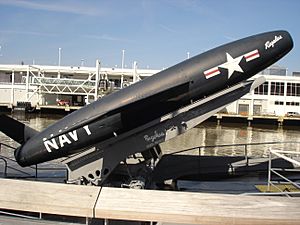
You can find Regulus missiles on display at several museums in the United States:
- Carolinas Aviation Museum, Charlotte, North Carolina: A Regulus I missile is displayed in a launch position. It's on a catapult stand, like those used on aircraft carriers.
- Frontiers of Flight Museum, Dallas Love Field, Texas: You can see a Regulus II missile here.
- Intrepid Sea-Air-Space Museum, New York City, New York: A Regulus I cruise missile is on board USS Growler, ready for a pretend launch.
- Point Mugu Missile Park, Naval Air Station Point Mugu, California: This museum has both a Regulus I and a Regulus II missile.
- USS Bowfin Museum, Pearl Harbor, Hawaii: This museum also has a Regulus missile.
- Veterans Memorial Museum, Huntsville, Alabama: Here you can see a Regulus II missile.
- Smithsonian Institution, Steven F. Udvar-Hazy Center: A Regulus I is on display here.
- New Jersey Naval Museum, Hackensack, New Jersey: This museum has a Regulus with its engine still inside.
- US Navy Pacific Missile Range Facility, Barking Sands, island of Kauai, Hawaii: A restored Regulus I is on display inside the North Gate.
Who Used the Regulus Missile?
 United States
United States
- United States Navy (from 1955 to 1964)
See also
 In Spanish: SSM-N-8A Regulus para niños
In Spanish: SSM-N-8A Regulus para niños


